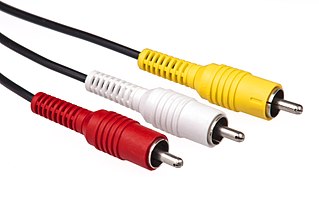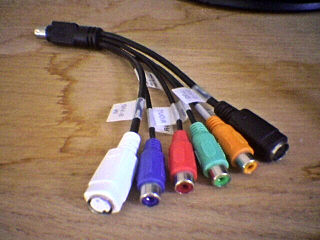
Digital Visual Interface (DVI) is a video display interface developed by the Digital Display Working Group (DDWG). The digital interface is used to connect a video source, such as a video display controller, to a display device, such as a computer monitor. It was developed with the intention of creating an industry standard for the transfer of digital video content.

An RF modulator is an electronic device whose input is a baseband signal which is used to modulate a radio frequency source.

SCART is a French-originated standard and associated 21-pin connector for connecting audio-visual (AV) equipment. The name SCART comes from Syndicat des Constructeurs d'Appareils Radiorécepteurs et Téléviseurs, "Radio and Television Receiver Manufacturers' Association", the French organisation that created the connector in the mid-1970s. The related European standard EN 50049 has been then refined and published in 1978 by CENELEC, calling it peritelevision, but it is commonly called by the abbreviation péritel in French.

Composite video is an analog video signal format that carries standard-definition video as a single channel. Video information is encoded on one channel, unlike the higher-quality S-video and the even higher-quality component video. In all of these video formats, audio is carried on a separate connection.

An RCA connector, sometimes called a phono connector or Cinch connector, is a type of electrical connector commonly used to carry audio and video signals. The name RCA derives from the Radio Corporation of America, which introduced the design by the early 1940s for internal connection of the pickup to the chassis in home radio-phonograph consoles. It was originally a low-cost, simple design, intended only for mating and disconnection when servicing the console. Refinement came with later designs, although they remained compatible.

S-Video is a signaling standard for standard definition video, typically 480i or 576i. By separating the black-and-white and coloring signals, it achieves better image quality than composite video, but has lower color resolution than component video.

S-VHS (スーパー・ヴィエイチエス), the common initialism for Super VHS, is an improved version of the VHS standard for consumer-level video recording. Victor Company of Japan introduced S-VHS in Japan in April 1987 with their JVC-branded HR-S7000 VCR, and in certain overseas markets soon afterward.
GeoPort is a serial data system used on some models of the Apple Macintosh that could be externally clocked to run at a 2 Mbit/s data rate. GeoPort slightly modified the existing Mac serial port pins to allow the computer's internal DSP hardware or software to send data that, when passed to a digital-to-analog converter, emulated various devices such as modems and fax machines. GeoPort could be found on late-model 68K-based machines as well as many pre-USB Power Macintosh models. Some later Macintosh models also included an internal GeoPort via an internal connector on the Communications Slot. Apple GeoPort technology is now obsolete, and modem support is typically offered through USB.

Component video is a video signal that has been split into two or more component channels. In popular use, it refers to a type of component analog video (CAV) information that is transmitted or stored as three separate signals. Component video can be contrasted with composite video in which all the video information is combined into a single line level signal that is used in analog television. Like composite, component-video cables do not carry audio and are often paired with audio cables.
A digital video recorder (DVR) is an electronic device that records video in a digital format to a disk drive, USB flash drive, SD memory card, SSD or other local or networked mass storage device. The term includes set-top boxes with direct to disk recording, portable media players and TV gateways with recording capability, and digital camcorders. Personal computers are often connected to video capture devices and used as DVRs; in such cases the application software used to record video is an integral part of the DVR. Many DVRs are classified as consumer electronic devices; such devices may alternatively be referred to as personal video recorders (PVRs), particularly in Canada. Similar small devices with built-in displays and SSD support may be used for professional film or video production, as these recorders often do not have the limitations that built-in recorders in cameras have, offering wider codec support, the removal of recording time limitations and higher bitrates.

HDMI is a proprietary audio/video interface for transmitting uncompressed video data and compressed or uncompressed digital audio data from an HDMI-compliant source device, such as a display controller, to a compatible computer monitor, video projector, digital television, or digital audio device. HDMI is a digital replacement for analog video standards.

Video in video out (usually seen as the acronym VIVO, commonly pronounced, is a graphics port which enables some video cards to have bidirectional analog video transfer through a mini-DIN connector, usually of the 9-pin variety, and a specialised splitter cable.

A composite monitor is any analog video display that receives input in the form of an analog composite video signal to a defined specification. A composite video signal encodes all information on a single conductor; a composite cable has a single live conductor plus earth. Other equipment with display functionality includes monitors with more advanced interfaces and connectors giving a better picture, including analog VGA, and digital DVI, HDMI, and DisplayPort; and television (TV) receivers which are self-contained, receiving and displaying video RF broadcasts received with an internal tuner. Video monitors are used for displaying computer output, closed-circuit television and other applications requiring a two-dimensional monochrome or colour image.
AV input is a common label on a connector to receive (AV) audio/visual signals from electronic equipment that generates AV signals.

The Macintosh Quadra 840AV is a personal computer designed, manufactured and sold by Apple Computer, Inc. from July 1993 to July 1994. It was introduced alongside the Centris 660AV, the "AV" after both model numbers signifying video input and output capabilities, as well as enhanced audio. The 840AV has the same mini tower form factor as the Quadra 800, with a faster Motorola 68040 processor.

An audio/video receiver (AVR) is a consumer electronics component used in a home theater. Its purpose is to receive audio and video signals from a number of sources, and to process them and provide power amplifiers to drive loudspeakers and route the video to displays such as a television, monitor or video projector. Inputs may come from a satellite receiver, radio, DVD players, Blu-ray Disc players, VCRs or video game consoles, among others. The AVR source selection and settings such as volume, are typically set by a remote controller.

The Twin Famicom is a home video game console that was produced by Sharp Corporation in 1986 and was only released in Japan. It is a licensed Nintendo product that combines the Family Computer (Famicom) and the Family Computer Disk System (FDS) into a single piece of hardware. Sharp removed most Nintendo branding from the system, even going as far as to remove the "Nintendo" branding from the Famicom Disk System startup, replacing it with the same "FAMICOM" logo used on the system itself.

The Dreamcast VGA Box is an accessory for Sega's Dreamcast video game console that allows it to connect to a video display such as a computer monitor or an HDTV set through a VGA port. Because the Dreamcast hardware can produce a VGA-compatible video signal natively, this connection provides improved picture quality compared to standard composite video or S-Video connections, along with support for progressive scan video.
Analog passthrough is a feature found on some digital-to-analog television converter boxes. Boxes without analog passthrough only allow digital TV to be viewed on older, analog-only TVs. Those with analog passthrough allow both digital and analog television to be viewed on older TVs.
Various accessories for the PlayStation 2 video game console have been produced by Sony, as well as third parties. These include controllers, audio and video input devices like microphones and video cameras, and cables for better sound and picture quality.















